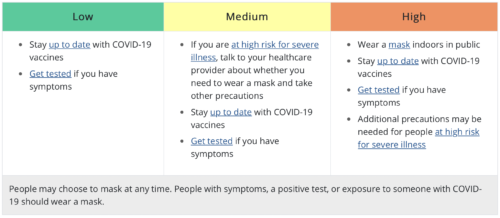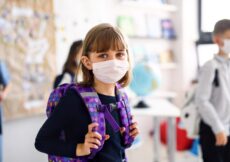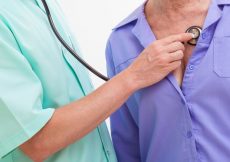February 28th, 2022
What Prevention Steps Should You Take Based on Your COVID-19 Community Level? (CDC 2/25/22)
With COVID-19 cases and hospitalizations plummeting after a vicious wintertime Omicron surge, the Centers for Disease Control and Prevention last week announced a new, more relaxed strategy for preventing communities across the nation from being overwhelmed by future waves of new variants. Apoorva Mandavilli charts the virus’s recent course:
The new guidelines are being released as the coronavirus is in retreat across the country. Case numbers have dropped to levels not seen before the surge of the Omicron variant, and hospitalizations have been plummeting. About 58,000 people are hospitalized with Covid nationwide, but those numbers have fallen by about 44 percent in the past two weeks.
More than 81% of Americans who are 5 years old and up and eligible to receive a COVID vaccine have gotten at least one shot, and 69% are fully vaccinated. Almost half (45%) of those 12 and older who can get a booster dose have already done so. With millions more who have gotten sick with COVID-19, it’s estimated that more than 90% of Americans living in some areas of the country may have some sort of immunity to SARS-CoV-2 — at least enough to warrant a change in the CDC’s recommendations.
Previous recommendations to help prevent community transmission relied only on the number of new COVID-positive tests recorded within a county. Now, the need for restrictions like wearing masks indoors and social distancing will be based on three factors:
• New hospital admissions due to COVID-19 over the previous 7 days
• The percentage of hospital beds occupied by patients with COVID-19
• The number of new cases per 100,000 people over the previous week
Taking these three factors into account, counties can now calculate whether the risk to their residents is low, medium, or high. The map below indicates that by the end of last week, Allegheny County in Pennsylvania was in the low risk category (click on image to enlarge it).
(Let’s take a moment to acknowledge Gov. Wolf’s announcement last week that 95% of Pennsylvania adults have received at least one COVID vaccine and 76% are fully vaccinated. Two shots (and a booster) are clearly better than one, but one shot provides more protection than none. The virus has shown it is highly capable of picking off the unvaccinated — 1,872 mostly unvaccinated Americans died every day on average over the last two weeks.)
Dr. Leana S. Wen explains why the CDC changed its policy on masking:
Previously, the Centers for Disease Control and Prevention’s sole determining factor for whether a community needed to implement masking was case counts. This made sense in 2020 and early 2021, when surges in infections invariably led to overwhelmed hospitals and deaths. But vaccines have rendered covid-19 far less severe. In areas with high levels of immunity from vaccination or prior infection, cases can be high, but hospitalizations remain low. The risk to society now correlates with severe infection, not positive tests, so it’s reasonable to shift the threshold for government-imposed restrictions.
According to the new guidelines, face masks (preferably N95 and KN95 respirators) are advised for public indoor spaces for everyone living in high risk counties. People at high risk for serious disease and poor outcomes from COVID-19 are advised to speak with their health providers about wearing a mask indoors if their community is in the medium (yellow) zone, although the CDC says “people may choose to mask at any time.” That is especially important for people 65 and older, some racial and ethnic minority populations, people with disabilities, and those who suffer from the long list of certain medical conditions that weaken the immune system or affect the resilience of anyone fighting this multi-system infection.
People experiencing symptoms of COVID-19, in isolation due to a positive COVID-19 test, or in quarantine after exposure to someone with COVID-19 should also wear a mask in public indoor spaces.
More than 70% of Americans at the moment live in low and medium risk counties, meaning they can stop wearing masks. In addition, social distancing and avoiding crowded indoor spaces are no longer advised for low- and medium-risk communities. For the time being, the recommendations do not apply to airports, airplanes, and other modes of public transportation. And masks will still be required when visiting hospitals and medical clinics.
Students attending public schools in low-risk and moderate-risk communities can also shed their masks and get chummy with their peers. That will make most kids and their parents very happy.
Not everyone is pleased with the new guidelines, however. Mandavilli says the CDC’s decision doesn’t have unanimous support:
And some officials in the C.D.C. and the Department of Health and Human Services are nervous about the changing guidance, according to an administration official who spoke on condition of anonymity.
Some public health experts also balked at the easing of restrictions, noting that the country is recording roughly 1,900 Covid-related deaths every day, children under 5 still do not have vaccines available to them and significant numbers of Americans remain at high risk because of their age, health status or occupation.
With the new guidelines, the CDC is saying that most of us can remove our masks when we gather indoors in public. But keep them close by in case a new variant comes along and drives up the number of new cases and hospitalizations:
The new set of guidelines gives people a framework for adapting precautions as virus levels change, Dr. Rochelle Walensky, the C.D.C.’s director, told reporters on Friday.
“We want to give people a break from things like masking when our levels are low, and then have the ability to reach for them again should things get worse in the future,” she said. “We need to be prepared and we need to be ready for whatever comes next.”
Keep track of the risk level in the county where you live here.





































